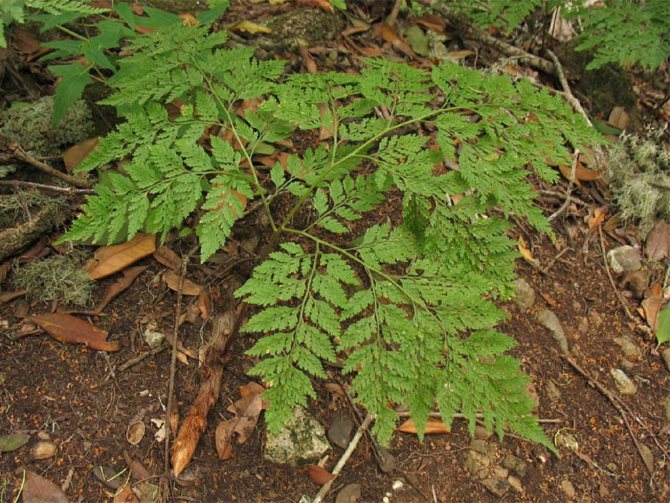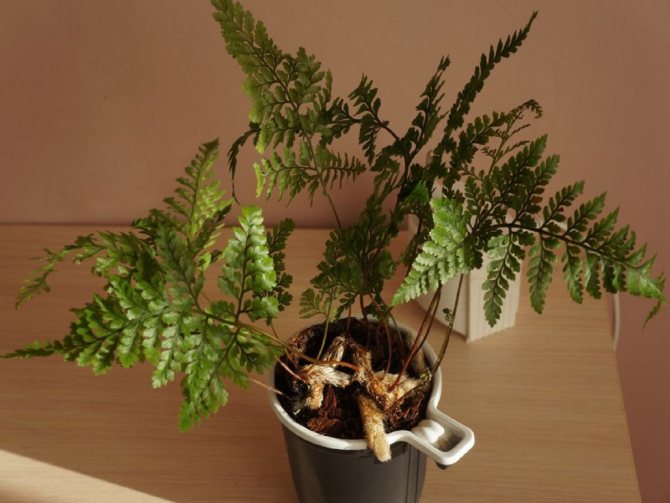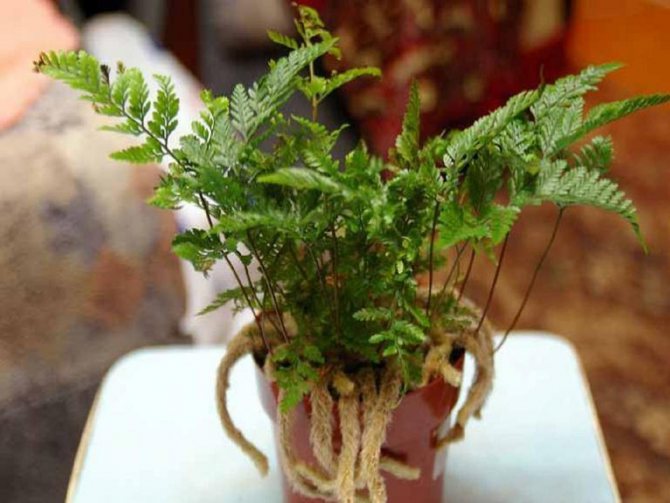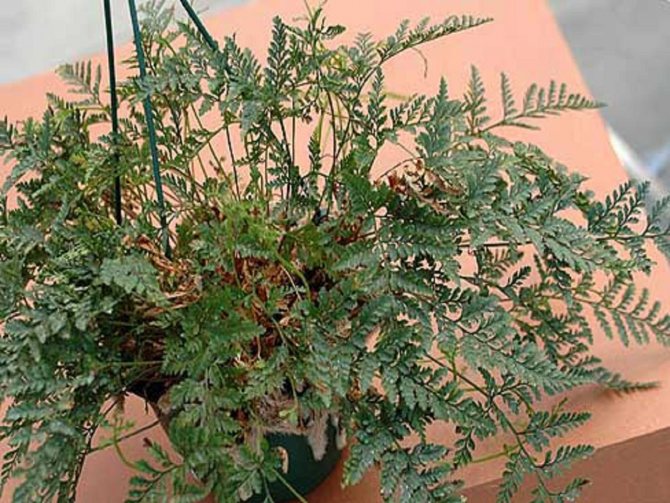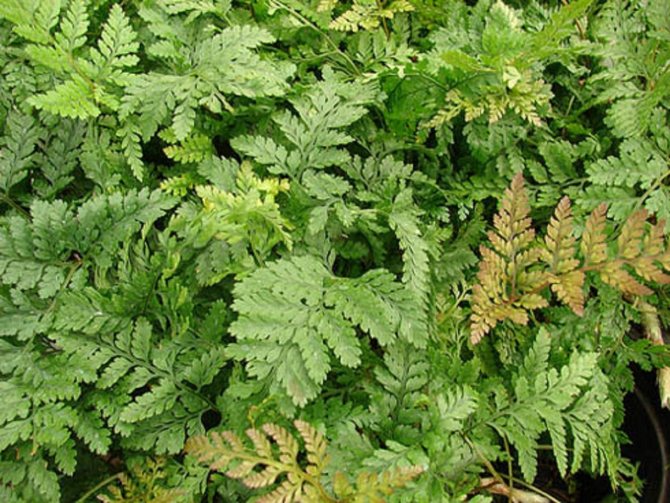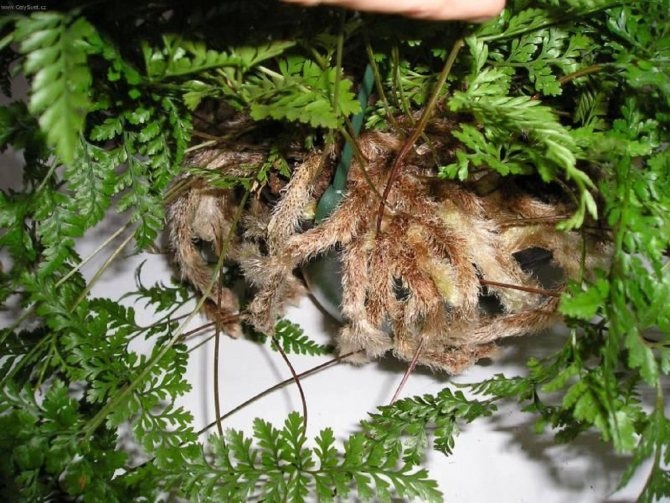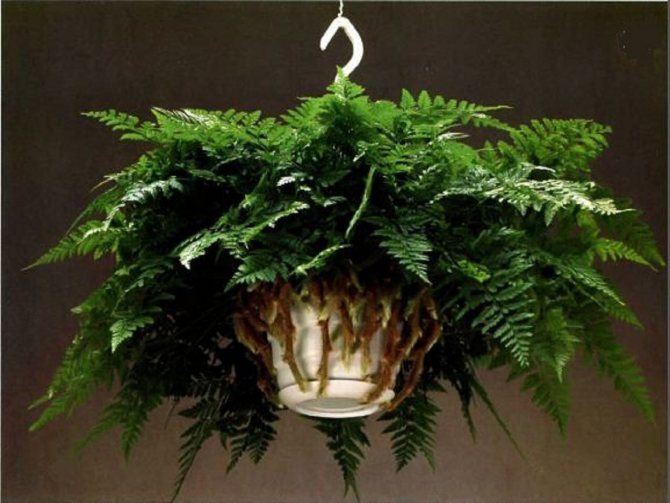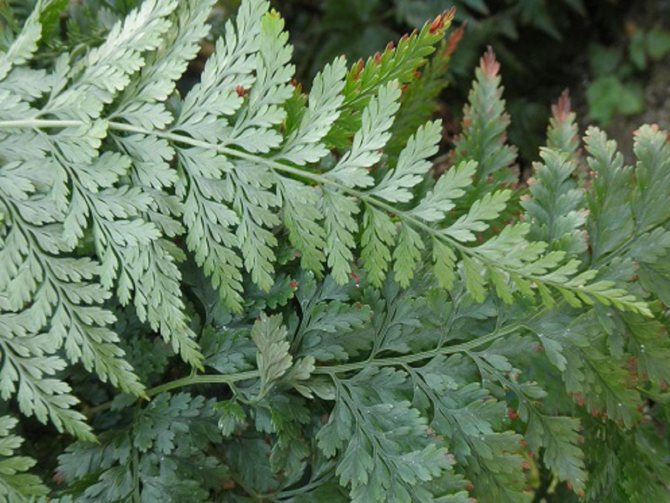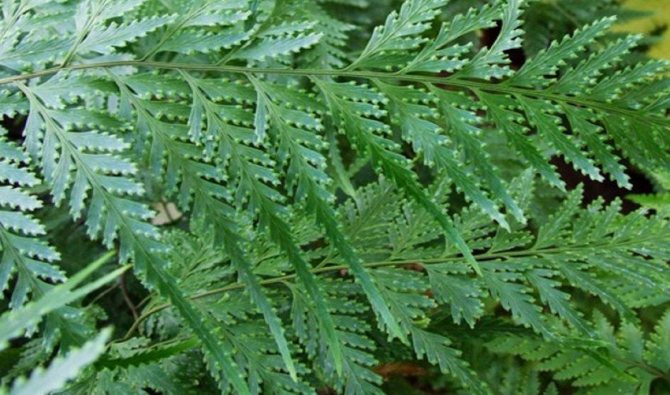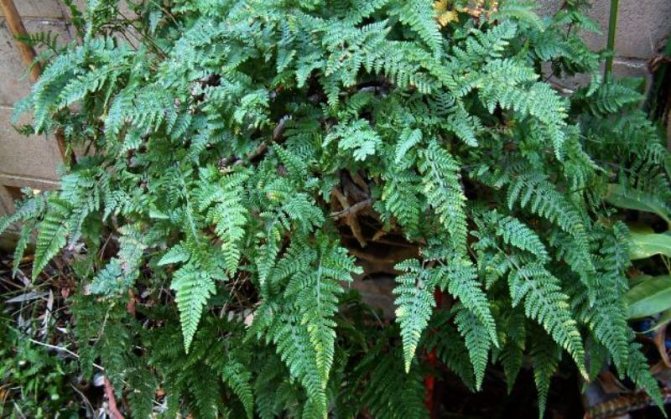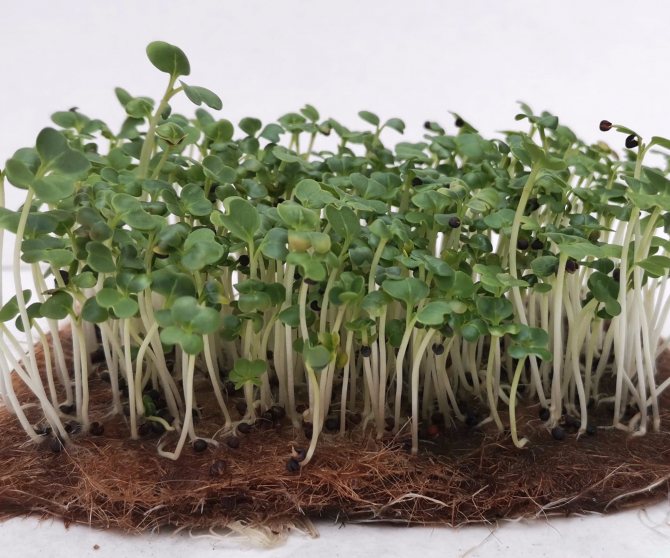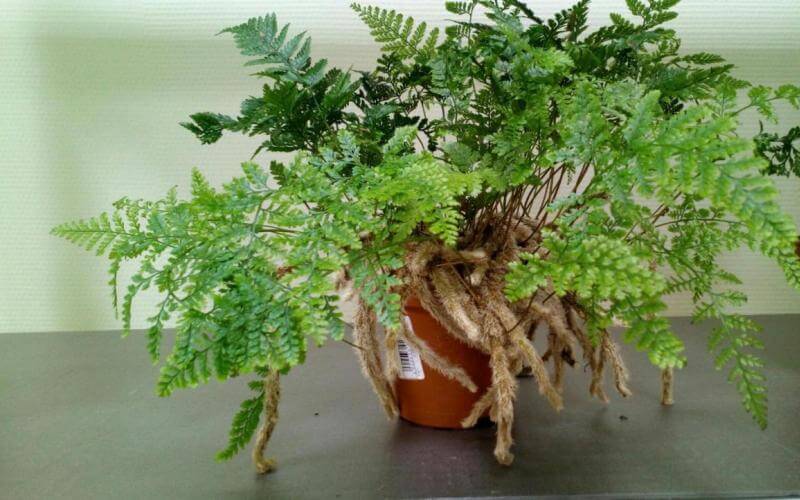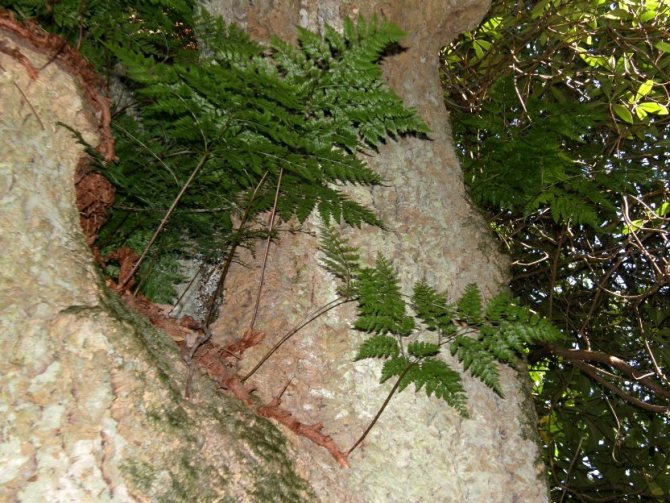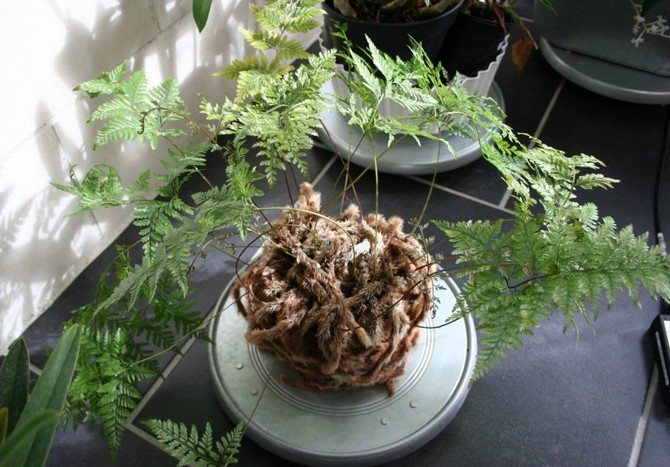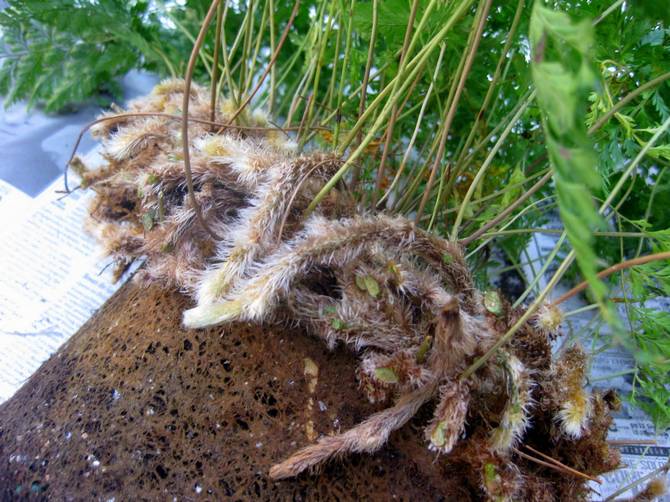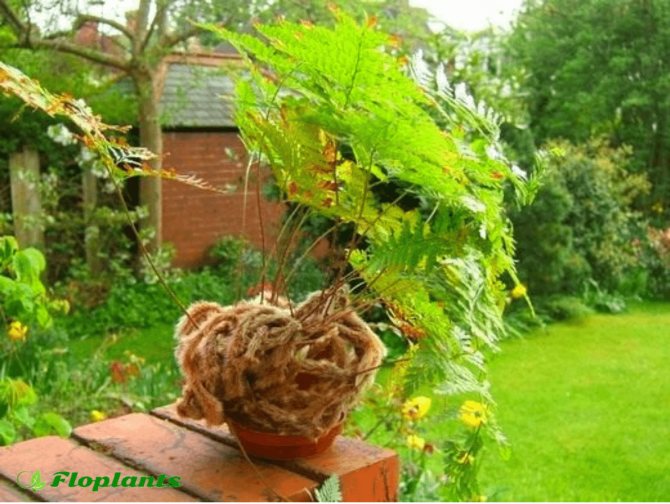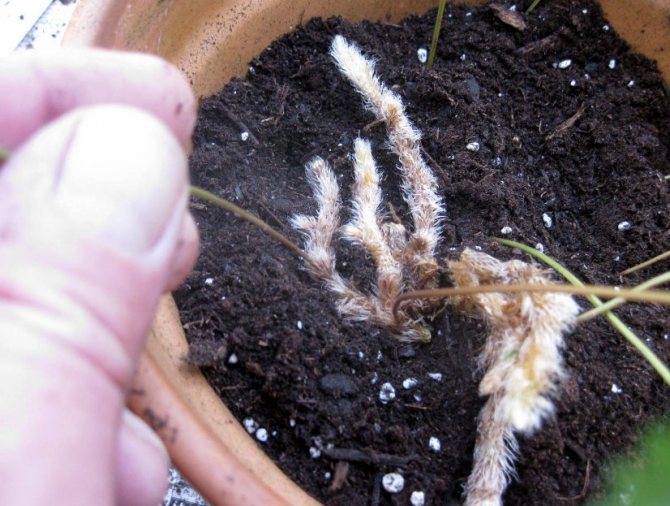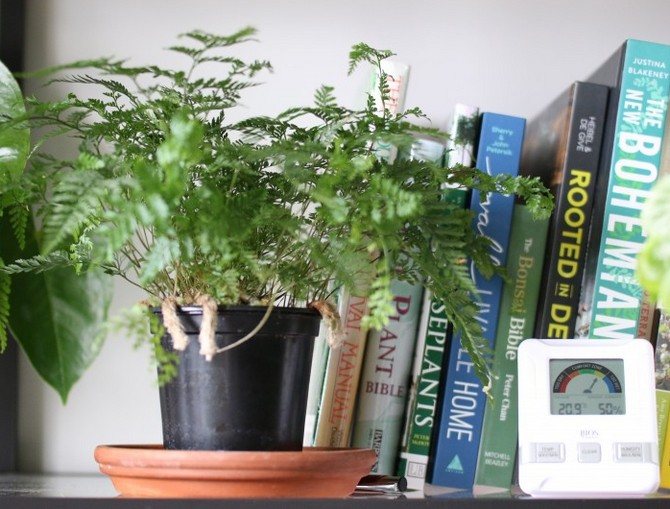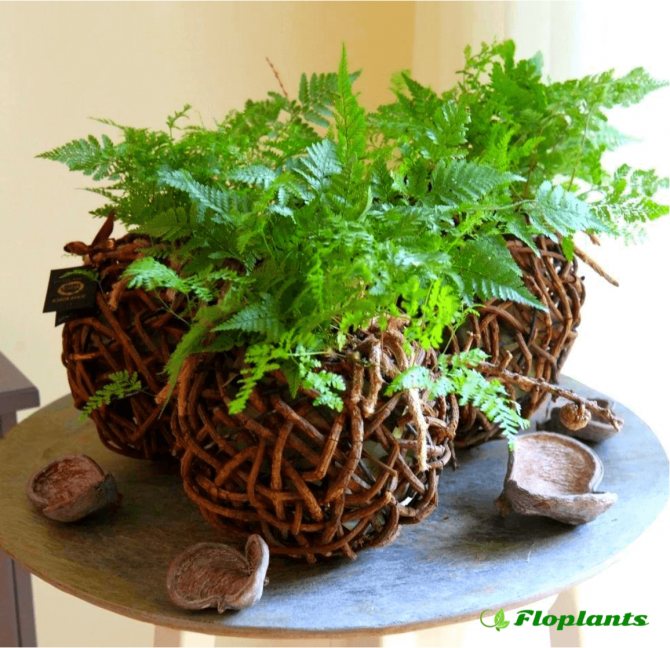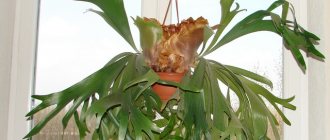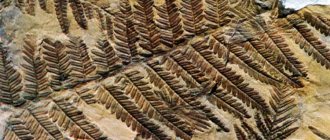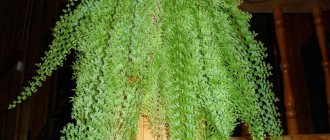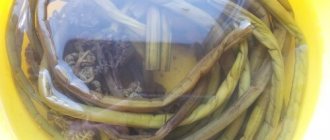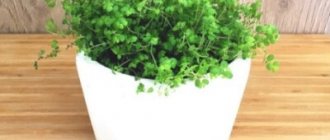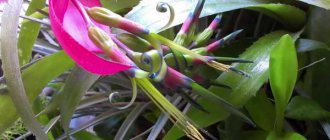Rabbit's foot, squirrel's foot, hare's paw, deer leg - such apt folk names were given to the tropical fern davallia for its exotic appearance. The roots of the plant, thick and shaggy, sprout up and hang over the edge of the pot, reaching a length of 90 cm. It is the roots of davallia that resemble the legs of medium-sized fluffy animals.
Davallia (lat Davallia) is a perennial epiphytic fern belonging to the family of the same name Davalliaceae. In the wild, it is most often found in Japan, China and the Canary Islands. Souvenirs made from this plant are widespread in Japan. In our latitudes, the fern is found as an ampelous indoor culture, as well as a plant for greenhouses and winter gardens.
At home, a fern is a small shrub consisting of branches with rather large carved decorative leaves of a bright green color, the shape of the leaf depends on the type of plant. Vayi davallia (the correct botanical name for fern leaves) grows actively during spring and summer and practically stops growing during dormant periods, in autumn and winter.
Davallia is not whimsical, but, like many ferns, especially tropical ones, it is demanding on the ambient temperature and air humidity. The fern is recommended to be grown in rooms with high humidity, or water often and constantly spray the plant. Some types of davallia can only be grown in winter gardens, since they require high air humidity and sometimes a rather low temperature, which is not attainable in a city apartment.
Description of the plant
Davallia is interesting for its reddish, shaggy rhizomes. The roots are thick, fleshy, covered with scales of various shapes, "crawl" out of the pot and very much resemble a "hare's foot" or "deer leg". You cannot cut them off. For this feature, the plant received its popular names. The length of the rhizome reaches ninety centimeters. The height of the plant is no more than fifty centimeters.

Florists are interested not only in the roots of the plant, but also in the leaves (fronds - as the botanists call fern leaves), triangular, pinnately dissected. From ten to thirty centimeters in length, reach ten to twenty centimeters in width. Davallia's leaves are bright green with a leathery surface. Petioles are boring in color with a glossy surface.
Davallia is a spore plant, so their leaves have sporangia, organs that produce spores. Sporangia are found at the top of the leaf and are spherical. Spores replace flowers for the plant. However, they are dangerous for people with asthma and can cause allergies.
Possible growing difficulties
Healthy davallia growing in suitable conditions rarely gets sick and is attacked by pests. In rare cases, from other plants, it can become infected with spider mites, aphids, scale insects, thrips. For prevention, it is recommended to systematically examine the plant, paying special attention to the underside of the leaf. The main problems are associated with care errors. Novice growers most often have to face the following problems:
The Davallia fern is interesting due to its unusual appearance and growth method.When growing it at home, in addition to openwork leaves, bizarre rhizomes hang from the pot, resembling the paws of a hare or the hairy limbs of a spider.
It is thanks to this feature that the people called this fern "hare paws". We present you with information about the intricacies of growing this wonderful plant and the specifics of caring for it in indoor conditions.
Types and varieties
Among the huge variety of ferns, only a few species are cultivated. All of them have a thick, pubescent rhizome. All types require very high humidity - 60-70%.
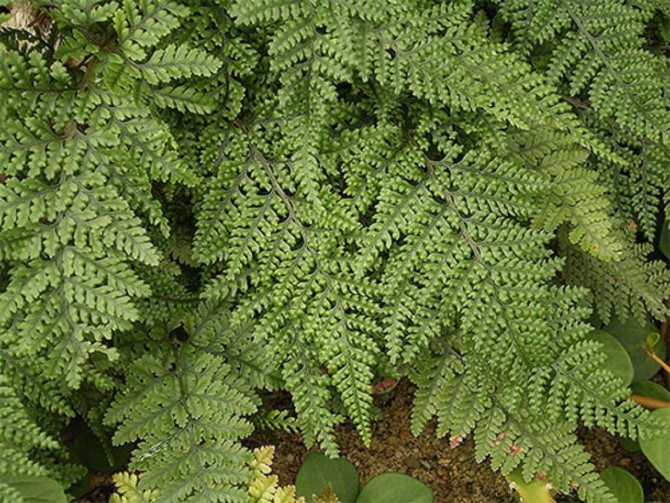

Davallia bladder
Davallia pentaphylla
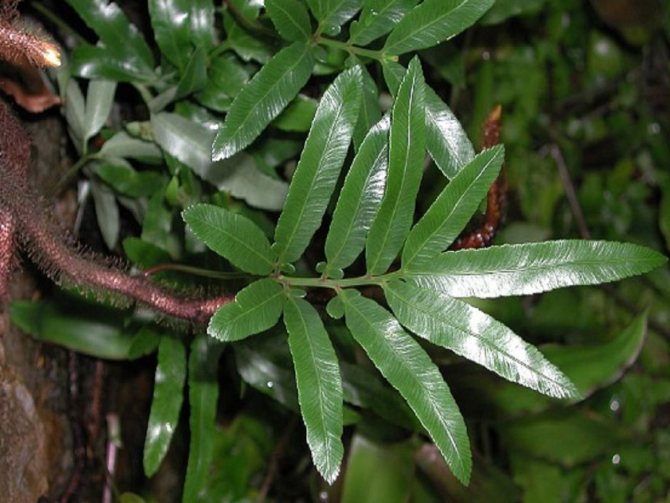

Davallia five-leafed
Davallia pentaphylla (Davallia pentaphylla) - is distinguished by the chocolate color of the roots. The petioles are much shorter than those of other davallia, the leaves are solid, glossy, of a rich green color. It is recommended to grow this subspecies indoors.
Davallia canariensis


Canary davallia
Davallia canariensis or Trichomanes canariensis is a subspecies imported from the Canary Islands and also lives on the Iberian Peninsula and North Africa. The roots are small, up to 15 centimeters. Leaves and petioles are of the same length, about 30 centimeters. The fronds are distinguished by their delicacy, they are feathery, dissected, in the shape of a diamond. Spores are densely located at the top of the leaf. This plant is quite decorative, feels comfortable in cool rooms. Davallia Canary does not require high humidity.
Davallia mariesii
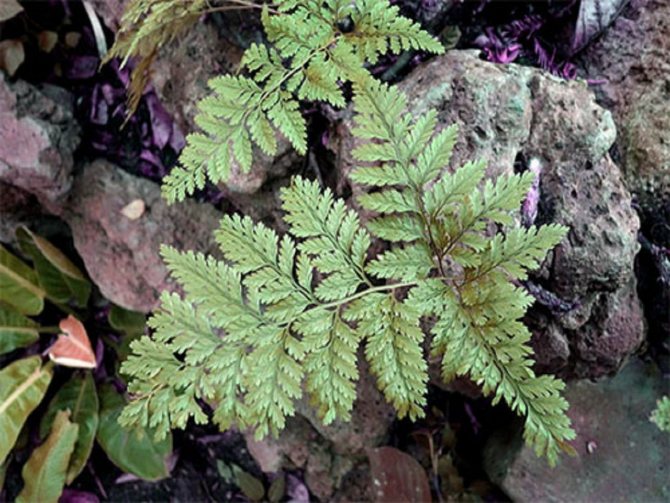

Davallia mariesa
Davallia mariesii. The homeland of this indoor plant is Japan. The dimensions of davallia maris reach 26 centimeters. The fronds, like all ferns, are feathery, in the shape of a triangle. The leaves are pale green, pubescent. The roots of this species are thin, covered with brick scales. Very often they are intertwined into a beautiful complex ornament.
Davallia solida
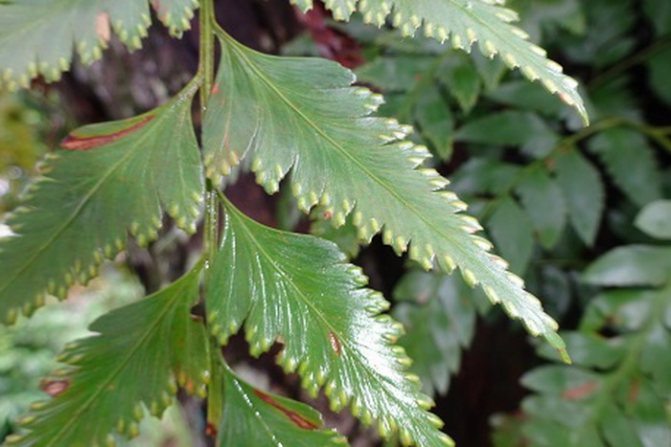

Davallia dense
Davallia dense (Davalliasolida). This species can be found in the Malay Archipelago, the Malay Peninsula, Polynesia and Australia. Curly, but the lobes are lined up like blades, so there is no such openwork as in the Canary. It is a perennial plant with wide, triangular, triple-plumose leaves. In length it grows to thirty to fifty centimeters, in width fifteen to twenty five centimeters. Sporangia are located one on each leaf lobe. The petioles are glossy, reaching thirty centimeters. The rhizome is thin, covered with scales in the form of threads. Gradually the roots grow stiff. This species can be grown as an ornamental ampelous plant in warm and humid greenhouses.
Interesting facts about davallia
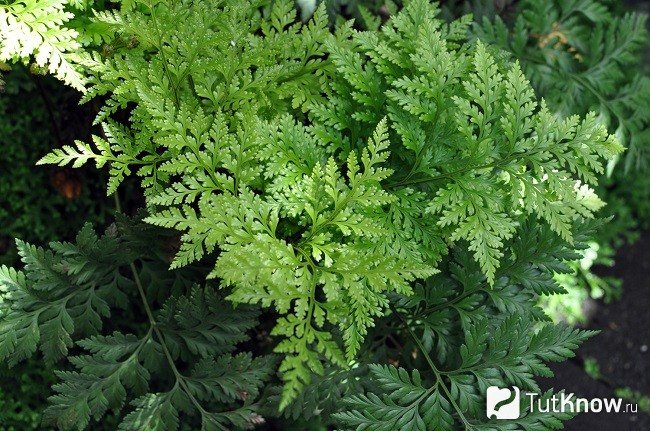

It is important to remember, since davallia is a fern plant, which gives spores instead of flowers, then in some people with high sensitivity it can cause not only allergies, but also asthma attacks. Such people are contraindicated.
In the wild, dawallia is found in Japan and has been exported to various countries for many years in the form of exotic souvenirs that resemble a monkey in their outlines.
Home davallia care
The plant does not require special care, it is completely non-capricious. It is not recommended to use plastic containers for growing it. At home, it is more expedient to grow dawallia in hanging baskets made of natural material.


Watering
For irrigation, use soft, lime-free water, which must be settled. The water temperature should be + 20 ... + 24 ° С. Watering should be done when drying the upper soil. In the summer they water it abundantly, but reduce it if rot appears on the surface of the hanging roots.For better watering and avoiding wetting of aerial roots, it is better to use a watering can with a narrow spout. Bottom watering is also used. To do this, a pot with a flower is placed for 20 minutes in a container with warm water, without lowering the ground roots into it. After water procedures, the plant is taken out of the water and allowed to drain well. The plant needs daily spraying. In winter, watering is reduced, but the drying of the earthy clod to dust is not allowed.
The soil
Fern soil can be purchased at specialized stores or made by yourself.
It must be remembered that this plant requires a well-drained light soil with a slightly acidic reaction.
The most suitable mixture is:
- 1 part - sod soil;
- 2 parts - peat;
- 1 part - sphagnum moss;
- 1 part pebbles or gravel.
Or mix in equal amounts - sand, peat and leafy soil. Orchid soil can be used.


Top dressing and fertilizers
From May to September, when the plant is in the stage of active growth, it is necessary to provide full feeding twice a month. Liquid fertilizers are used for ornamental deciduous plants. Fertilizers should be diluted in half with soft water, which is used for irrigation. During the dormant period, from September to April, the use of top dressing can lead to diseases.
Important! Fertilize the plant separately from watering.
Location and lighting
The plant does not need a lot of light, it feels good under diffused rays on the windowsills of the east and west windows. Placing davallia on the south window in direct sunlight can harm the plant, the leaves will get burned. If, after all, the flower is on the south side, provide shade from February to August.
Air humidity
Davallia does not tolerate dry air and is demanding of high humidity. It is difficult to achieve optimal conditions in apartments, therefore, dawallia is often grown in greenhouses. Only by providing the fern with high humidity, about 50-60 percent, you can get a lot of new and fresh leaves. In a dry room, try to spray the plant more often with a fine spray bottle. This will help prevent the frond tips from drying out.
Canary dawallia tolerates dry air more easily than all fern species.
In summer, davallia can be moved to the garden, balcony or terrace.


Temperature
The optimum temperature for the existence of davallia is + 18 ... + 25 ° С. These indicators are important to maintain for blistering and dense davallia. Davallia Canary is less whimsical, withstands +17 degrees. At lower temperatures, the plant loses its leaves and may die. It is important to protect the fern from drafts.
Pruning
Having a decorative and neat appearance, davallia practically does not need pruning. Only sick and dry fronds need to be removed, they are separated near the very base.
Possible difficulties in growing davallia
If your pet has problems, he himself will tell about his appearance, you just need to watch him more often.
- Leaves turn yellow or dry - the plant lacks moisture;
- Vai turned pale, became lethargic - most likely a lot of sunshine;
- New leaves quickly fall off, curl - the plant is cold, perhaps the water is not soft enough;
- The crown is not lush - not enough light;
- If the plant has stopped growing, it's time to transplant, it is cramped in the pot
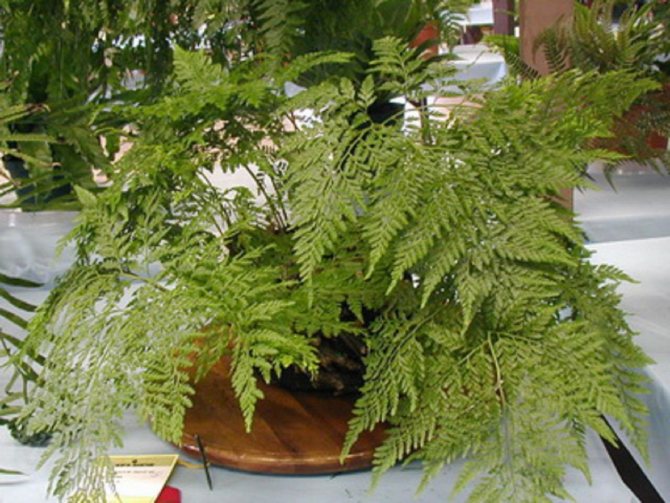

Transplantation and reproduction of davallia
She needs a transplant once every two years. During this time, the roots have time to fill the entire pot, the plant stops growing. The container is chosen shallow, since the roots are located close to the surface. The bottom is laid out with drainage. It is better to replant in early or mid-spring.The soil for transplantation and reproduction should be prepared as for an adult plant: sand, leafy earth, sphagnum - all in equal parts.
Davallia multiplies in several ways. Basically, flower growers use division and reproduction by layering.
In an adult plant, young bushes appear on fluffy roots. They are carefully cut and placed on prepared, moistened soil. The plant is not sprinkled, but only slightly pressed. You can fix the young sprout with expanded clay so that it does not fall. The pot with the new plant is placed in a bag and sprayed with warm water twice a day. Make sure that the package is open, this will help to avoid excessive moisture, exclude the process of rotting leaves. The plant takes root slowly, the first roots will appear in about two months.
Sometimes growers propagate the fern with spores. They are germinated by placing them in a sand-peat mixture in a warm room.
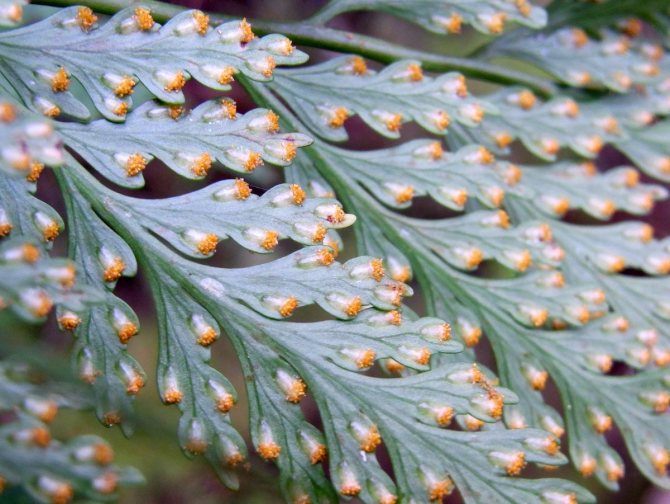

Fern breeding methods
If the grower needed another davallia, it can be propagated in several ways:
- Rhizome... Pieces of root with stems and fronds growing from them must be planted in a moist substrate by placing the "squirrel's feet" on the ground and lightly pressing them in or fixing them on the ground surface. After a while, young bushes will grow on the fluffy roots.
- By dividing the bush... This breeding method is carried out in the same way as described above. The only difference is that large parts of the bush are placed for rooting, divided for these purposes with a sharp knife. Slices must be sprinkled with crushed coal.
- Disputes... As you know, davallia does not bloom, but gives spores. If you dry them and plant them in disinfected peat soil, and then cover the container with polyethylene and place in a dark and warm place, after a while you can wait for shoots.
When transplanting, you cannot bury the roots of davallia, you just need to bury some of them slightly in the ground, or first immerse the roots in a pot, and then fill it with soil.
Diseases and pests
Davallia can get sick with improper care.
Root rot affects the fern when over-watered. The decayed roots must be removed, the cuts must be sprinkled with charcoal. To reanimate the plant, it should be transplanted into fresh soil.
In case of a fungal disease, the affected areas are also cut off and the cuts are sprinkled with ash. The diseased plant is treated with the Mikosan preparation.
Of the pests, the fern is afraid of aphids, scale insects, whiteflies, mealybugs, spider mites, thrips. The affected plant is treated with insecticides. You can use folk remedies, for example, a shower with laundry soap is very effective in combating many pests.
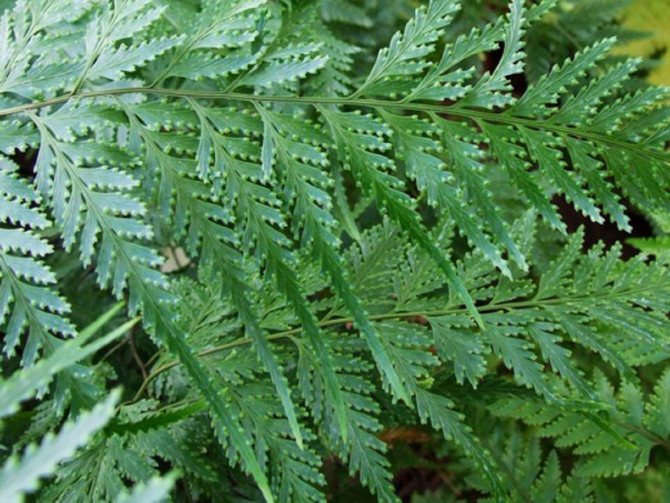

Possible difficulties
During the life of davallia, some problems can arise that are easy to deal with if the signals of the plant are correctly understood:
- curling and falling of green leaves - the air temperature is too low;
- yellowing and drying of leaves - insufficient moisture level;
- the appearance of yellow and brown spots on the leaves - sunburn;
- slow growth - overly dense soil.
Parasites (aphids, ticks, worms, whiteflies, scale insects, thrips) show interest in the lush green of the fern. To control pests, it is better to use insecticides right away.
Post Views: 1

